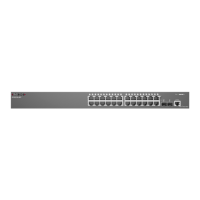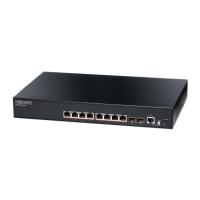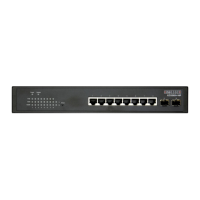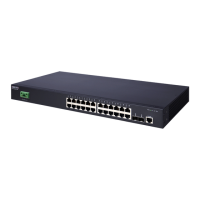Chapter 5
| Port Connections
How to Connect to Twisted-Pair Copper Ports
– 39 –
Copper Cabling
Guidelines
To ensure proper operation when installing the switch into a network, make sure
that the current cables are suitable for 10BASE-T, 100BASE-TX, or 1000BASE-T
operation. Check the following criteria against the current installation of your
network:
◆ Cable type: Unshielded twisted pair (UTP) or shielded twisted pair (STP) cables
with RJ-45 connectors; Category 5, 5e or better cable for 1000BASE-T
connections, Category 5 or better for 100BASE-TX connections, and Category 3
or better for 10BASE-T connections.
◆ Protection from radio frequency interference emissions
◆ Electrical surge suppression
◆ Separation of electrical wires (switch related or other) and electromagnetic
fields from data based network wiring
◆ Safe connections with no damaged cables, connectors or shields
10/100BASE-TX Pin
Assignments
All 100BASE-TX RJ-45 ports support automatic MDI/MDI-X operation, so you can
use straight-through or crossover cables for all network connections to PCs,
switches, or hubs. In straight-through cable, pins 1, 2, 3, and 6, at one end of the
cable, are connected straight through to pins 1, 2, 3, and 6 at the other end of the
cable.
Figure 21: RJ-45 Connector
RJ-45 Pin Numbers
Table 5: 10/100BASE-TX MDI and MDI-X Port Pinouts
Pin
MDI Signal Name
*
MDI-X Signal Name
1 Transmit Data plus (TD+)
-52V power (Negative V
port)
Receive Data plus (RD+)
GND (Positive Vport)
2 Transmit Data minus (TD-)
-52V power (Negative V
port)
Receive Data minus (RD-)
GND (Positive Vport)
3 Receive Data plus (RD+)
GND (Positive V
port)
Transmit Data plus (TD+)
-52V power (Negative Vport)
4 -52V power (Negative Vport) GND (Positive Vport)
5 -52V power (Negative Vport) GND (Positive Vport)

